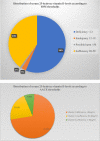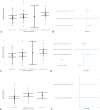Beta cell function, insulin resistance and vitamin D status among type 2 diabetes patients in Western Kenya
- PMID: 33602978
- PMCID: PMC7892854
- DOI: 10.1038/s41598-021-83302-0
Beta cell function, insulin resistance and vitamin D status among type 2 diabetes patients in Western Kenya
Abstract
Serum vitamin D status exerts effects on glucose-insulin-homeostatic states underlying Diabetes-Mellitus, Type 2 (T2DM). This has been described in white and Asian population where low Vitamin D levels predicted future impairments in beta cell function and worsening of insulin resistance. This study aimed to examine the relationship between serum vitamin D, insulin resistance and beta cell function in a sub population of black Kenyan T2DM patients. The primary objective was to determine the levels of serum 25 hydroxy (25-OH) vitamin D, and estimate the insulin resistance, and beta cell function among T2DM patients at Moi Teaching and Referral Hospital (MTRH). This was a cross sectional study. 124 T2DM patients attending the MTRH Diabetes clinic between February and May 2016 were enrolled. Patients on insulin therapy and/or thiazolidinediones were excluded. Anthropometric, clinical and demographic data was obtained. Samples were drawn for estimation of serum 25-OH vitamin D, fasting insulin levels and fasting blood glucose levels. HOMA (Homeostatic model of assessment) model was used to estimate Beta cell secretion (HOMA-B) and insulin resistance (HOMA-IR); while the Disposition index {(DI) hyperbola product of insulin sensitivity (1/HOMA-IR) and beta cell secretion} was used to estimate the beta cell function. The relationships between serum vitamin D, insulin resistance and beta cell function were explored using a linear regression model. The study participants had a mean age of 56.2 (± 9.2) years, and a mean BMI of 26.9 kg/m2 (4.3). Forty nine percent (n = 61) were males. Vitamin D deficiency was present in 71.1% (n = 88) of the respondents. Relatively low levels of insulin resistance and higher levels of beta cell dysfunction were observed {median HOMA-IR of 2.3 (0.7, 6.5) and Disposition Index (DI) of 25.5 (14.3, 47.2)}. Vitamin D levels exhibited a low positive correlation with DI [r = 0.22 (95% CI: 0.03, 0.37)], but was not significantly correlated with HOMA-IR [r = 0.07(95% CI: - 0.11, 0.25)]. These results indicate that beta cell dysfunction rather than insulin resistance as the predominant defect among black T2DM patients seeking care at the MTRH diabetes clinic. Vitamin D deficiency is also prevalent among them and exhibits a low positive correlation with beta cell dysfunction. There was no correlation observed between Vitamin D deficiency and insulin resistance.
Figures






References
MeSH terms
Substances
Grants and funding
LinkOut - more resources
Full Text Sources
Other Literature Sources
Medical

